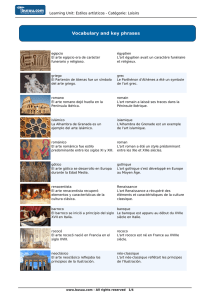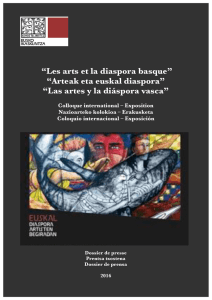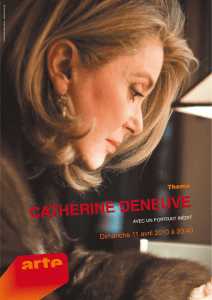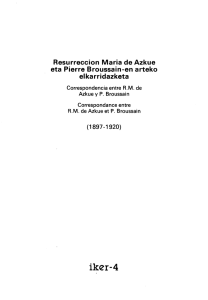Arte Plastikoak: Ondorioak = Artes Plásticas: Conclusiones = Arts
Anuncio
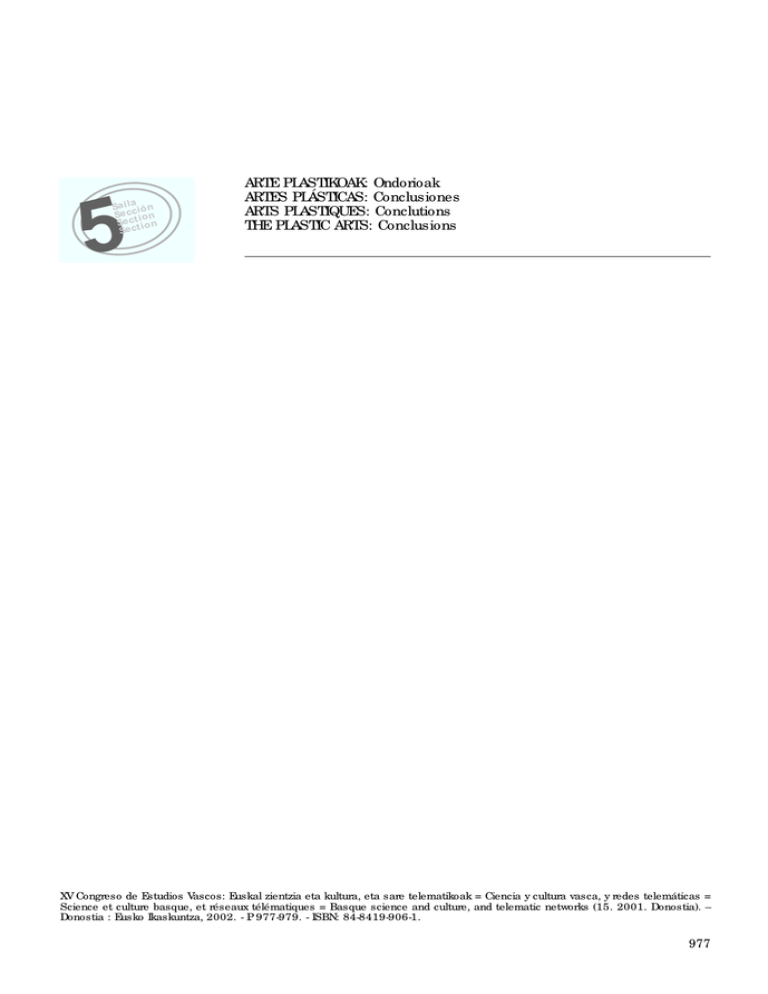
Sa i l aci ó n Se c t i o n Se c t i o n Se c 5 ARTE PLASTIKOAK: Ondorioak ARTES PLÁSTICAS: Conclusiones ARTS PLASTIQUES: Conclutions THE PLASTIC ARTS: Conclusions XV Congreso de Estudios Vascos: Euskal zientzia eta kultura, eta sare telematikoak = Ciencia y cultura vasca, y redes telemáticas = Science et culture basque, et réseaux télématiques = Basque science and culture, and telematic networks (15. 2001. Donostia). – Donostia : Eusko Ikaskuntza, 2002. - P. 977-979. - ISBN: 84-8419-906-1. 977 Ondorioak. Conclusiones. Conclutions. Conclusions ONDORIOAK XX. mendearen azken herenean, Euskal Arteaz hitz egitetik Euskal Herrian egindako Arteaz hitz egitera pasa gara. Bertakoaren erreibindikazio gisa erabili identitate kontzeptutik (60. urteetako Euskal Eskolaren ezaugarria) globalizazio kontzeptura pasa gara. Euskal Herrian egindako artea gaur egun homologaturik dago nazioarteko mailan. 80etatik aurrera agertu diren belaunaldi berrientzat, identitatea gizabanako sortzailearen bilaketa da, talde identitatearen bilaketa baino areago. Horrek ez du esan nahi inguruneak artistaren baitan eraginik ez izatea. Nabarmendu beharra dago preskuntzarako baliabide eta aukera gehiago daudela Euskal Herrian beste zenbait autonomiatan baino. Euskadiko Unibertistateak burutu duen eginkizuna (Arkitektura, Arte Ederretako eskolak…), Arteleku bezalako zentroak, erakusketa aretoak, Guggenheim fenomenoa… erabakigarriak izan dira artista ugari ager daitezen, eta horien artean azpimarratzekoa da emakumeak artearen munduan egin duen sarrera sendoa. Asko eztabaidatu da Teknologia Berriak, simulazio birtualaren bidez, noraino ordezkatzen ari diren errealaren irmotasuna. Zenbait diziplinari dagokie- nez, hala nola arkitekturaren alorrean, Patxi Mangado txostengileak adierazi duenez, arkitektura marraztua ez da arkitektura, ariketa formal eta estilistiko soila baizik. Beste zenbait kasutan, oroitarazi dugu, aibidez, pintura beti izan dela errealitate birtuala (Magritte, Hau ez da pipa bat) eta pantailako pixela argi puntu bat dela, lapitzaren punta bezain erreala. Agerikoa gertatzen da arteen arteko mugak gainditu izana. Eklektizismoa, mestizajea, dekonstrukzioa, edotariko gaien, hizkuntzen eta baliabideen erabilera (argia, soinua, teknologia berriak…) dira gaurko Artearen egoeraren ezaugarria. Esperientzia hibridoak arrakastatsu gertatzen dira, hala nola instalazioak, performanceak, bideoartea, argazki digitala, netart, arte interaktiboa, ciberart… Gaur egungo egoeraren erakusgarri, XV. Kongresuarekin batera, “Arte elektronikoa Euskal Herrian” erakusketa antolatu da, Arte Ederrak sailaren ardurapean, Miramongo Kutxagunean, Zientzia Museoan. Oro har, Euskal Herriko Artearen osasun egoera ona egiaztatu egin da, sortzaile ugari eta kalitatezkoak agertzen direla alor guztietan, eta nazioarteko panoraman modu interaktiboan dihardutela, gure inguruko herrialdeen maila berean. CONCLUSIONES En el último tercio del siglo XX, hemos pasado de hablar del Arte Vasco a hablar de Arte hecho en el País Vasco. Del concepto de identidad como reivindicación de lo autóctono (lo que caracterizó a la Escuela Vasca de los 60) hemos pasado al concepto de globalización. El arte hecho en el PV está hoy homologado a nivel internacional. En las nuevas generaciones surgidas a partir de los 80, la identidad es más una búsqueda de la individualidad creadora que de una identidad colectiva. Ello no obsta para que el entorno influya en el artista. Hay que destacar el hecho de que en el PV los medios y posibilidades de formación son mayores que en otras autonomías. El papel jugado por la universidad vasca (escuelas de Arquitectura, de Bellas Artes…), centros como Arteleku, salas de exposiciones, el fenómeno Guggenheim, han sido decisivos para la aparición de numerosos artistas entre los que hay que destacar la fuerte irrupción de la mujer en el mundo del arte. Se ha debatido sobre hasta qué punto con las Nuevas Tecnologías la simulación de lo virtual suplanta la solidez de lo real. Hay disciplinas, como la arquitectura, donde el ponente (Patxi Mangado) 978 afirma que la arquitectura dibujada no es arquitectura sino un mero ejercicio formal y estilístico. En otros casos, se recuerda que por ejemplo, la pintura siempre ha sido una realidad virtual (Magritte, Esto no es una pipa) y que el pixel de la pantalla es un punto de luz tan real como la punta de un lápiz. Resulta evidente la superación de las barreras entre las artes, el eclecticismo, el mestizaje, la deconstrucción, la utilización de los más diversos materiales, lenguajes y herramientas (luz, sonido, Nuevas Tecnologías…), caracterizan a situación actual del Arte. Triunfan las experiencias híbridas, como instalaciones, performances, videoarte, fotografía digiotal, netart, arte interactivo, ciberart… Como escaparate de la situación actual se ha organizado en paralelo al XV Congreso la exposición “Arte electrónico en Euskal Herria”, organizado por la sección de Bellas Artes en el Kutxaespacio de Miramón, Museo de la Ciencia. En general s e cons tata el buen es tado de salud del Arte en el País Vasco con la abundancia y calidad de creadores en todos los ámbitos, y su interacción en el panorama internacional, en pie de igualdad con los países de nuestro entorno. Ondorioak. Conclusiones. Conclutions. Conclusions CONCLUTIONS Dans le de rnie r tie rs du XXe s iè cle , no us avons parlé premièrement de l’Art Basque pour parler ensuite de l’Art réalisé dans le Pays Basque. Du concept d’ identité en tant que revendication de ce qui est autochtone (ce qui caractérisa l’ Ecole Basque des années 60), nous sommes passé au concept de globalisation. L’ art réalisé au Pays Basque est aujourd’ hui homologué à niveau international. Dans les nouvelles générations apparues à partir des années 80, l’ identité est plus une recherche de l’ individualité créatrice que une identité collective. Cela n’ empêche pas que l’ environnement ait une influence sur l’artiste. Il faut souligner le fait que dans le Pays Basque les moyens et les possibilités de formation sont plus importants que dans d’ autre autonomies. Le rôle joué par l’ université basque (écoles d’ Architecture, des Beaux-Arts...), des centres comme Arteleku, des sales d’expositions, le phénomène Guggenheim, ont été décisifs pour l’ apparition de nombreux artistes parmi lesquels il faut mentionner une forte irruption de la femme dans le monde de l’art. On a débattu pour savoir jusqu’ à quel point, avec les Nouvelles Technologies, la simulation de ce qui est virtuel supplante la solidité de ce qui est réel. Il y a des disciplines, comme l’architecture, où le conférencier (Patxi Mangado) affirma que l’architecture dessinée n’est pas de l’architecture mais un simple exercice formel et stylistique. Dans d’autres cas, on rappelle que, par exemple, la peinture a toujours été une réalité virtuelle (Magritte, Cela n’est pas une pipe) et que le pixel de l’écran est aussi réel que la pointe d’un crayon. Il est évident que le dépassement des barrières entre les arts, l’ éclectisme, le métissage, la démolition, l’ utilisation des matériaux les plus divers, langages et outillages (lumière, son, Nouvelles Technologies...), caractérisent la situation actuelle de l’ Art. Les expériences hybrides, telles qu’installations, performances, vidéoart, photographie digitale, netart, art interactif, ciberart.... triomphent. Comme vitrine de la situation actuelle on a organisé, en parallèle au XVe Congrès, l’exposition “Art électronique en Euskal Herria”, organisée par la section des Beaux-Arts au Kutxaespacio de Miramón, Musée de la Science. On constate, en général, le bon état de santé de l’Art dans le Pays Basque avec l’abondance et la qualité de créateurs dans tous les milieux, et son interaction dans le panorama international, à égalité avec les pays qui nous entourent. CONCLUSIONS During the last third of the 20th century we have gone from speaking of new Basque art be to speaking of art made in the Basque country. From a concept of a identity as a rare vindication of what is autochthonous (which characterised the Basque school of the 1960s) we have passed to the concept of globalis ation. Art made in the Bas que country has now been internationally certified. In the new generations that arose in the 1980s, identity is more of a search for creative individuality than a collective identity. This is not an obstacle for the environment to influence the artist. One must emphasise the fact that in the Basque Country there are more possibilities of training than in other autonomous communities. The role of Basque university (architecture schools fine art schools...) centres like Arteleku, exhibition halls, the Guggenheim phenomenon, have been decisive in the appearance of numerous artists among which one must point out the appearance in strength of women in the world of art. There has been a lot of debate on up to what point the simulation of virtuality with new technologies has substituted the solidity of the real world. There are disciplines, like architecture, where the speaker (Patxi Mangado) states that the draughtsman’s architecture is not architecture but a mere formal and stylistic exercise. In other cases, he reminded us that, for example, painting has always been a virtual reality (Magritte, This is not a pipe) and that the pixel in a screen is a point of light that is as real as a dot made by a pencil. It is evident that the overcoming of barriers between the arts, that eclecticism, mixture, deconstruction, the use of the most diverse materials, languages and tools (light, sound, new technologies...), characterise the current situation of Art. Hybrid experiments triumph, as is the case with installations, performances, videoart, digital photography, netart, interactive art, cyberart, etc. As a showcase of the current situation the exhibition “Electronic Art in the Basque Country” was organised in parallel to the XV Congress within the Miramón Kutxaespacio Museum of Science. In general terms, the good state of health of art in the Basque country was observed and certified with an abundance of creators in all fields and its interaction in the international panorama in an e qual fo o ting with the c o untrie s that surround us. 979

